Berg J.M., Tymoczko J.L., Stryer L. Biochemistry
Подождите немного. Документ загружается.


II. Transducing and Storing Energy 14. Metabolism: Basic Concepts and Design 14.2. The Oxidation of Carbon Fuels Is an Important Source of Cellular Energy
Figure 14.9. Free Energy of Oxidation of Single-Carbon Compounds.
II. Transducing and Storing Energy 14. Metabolism: Basic Concepts and Design 14.2. The Oxidation of Carbon Fuels Is an Important Source of Cellular Energy
Figure 14.10. Prominent Fuels. Fats are a more efficient fuel source than carbohydrates such as glucose because the
carbon in fats is more reduced.
II. Transducing and Storing Energy 14. Metabolism: Basic Concepts and Design 14.2. The Oxidation of Carbon Fuels Is an Important Source of Cellular Energy
Figure 14.11. Proton Gradients. The oxidation of fuels can power the formation of proton gradients. These proton
gradients can in turn drive the synthesis of ATP.
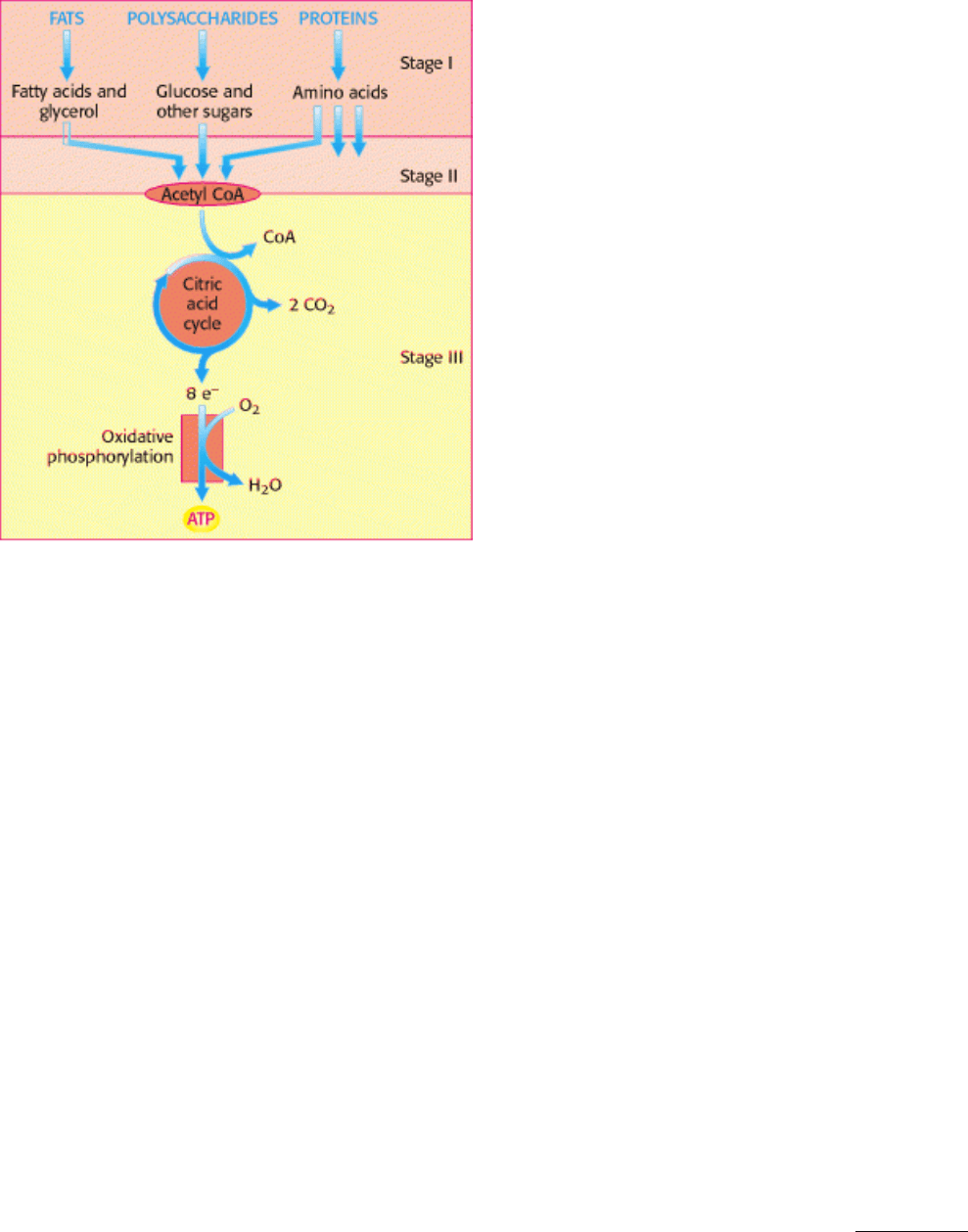
II. Transducing and Storing Energy 14. Metabolism: Basic Concepts and Design 14.2. The Oxidation of Carbon Fuels Is an Important Source of Cellular Energy
Figure 14.12. Stages of Catabolism. The extraction of energy from fuels can be divided into three stages.
II. Transducing and Storing Energy 14. Metabolism: Basic Concepts and Design
14.3. Metabolic Pathways Contain Many Recurring Motifs
At first glance, metabolism appears intimidating because of the sheer number of reactants and reactions. Nevertheless,
there are unifying themes that make the comprehension of this complexity more manageable. These unifying themes
include common metabolites, reactions, and regulatory schemes that stem from a common evolutionary heritage.
14.3.1. Activated Carriers Exemplify the Modular Design and Economy of Metabolism
We have seen that phosphoryl transfer can be used to drive otherwise endergonic reactions, alter the energy of
conformation of a protein, or serve as a signal to alter the activity of a protein. The phosphoryl-group donor in all of
these reactions is ATP. In other words, ATP is an activated carrier of phosphoryl groups because phosphoryl transfer
from ATP is an exergonic process. The use of activated carriers is a recurring motif in biochemistry, and we will
consider several such carriers here.
1. Activated carriers of electrons for fuel oxidation. In aerobic organisms, the ultimate electron acceptor in the oxidation
of fuel molecules is O
2
. However, electrons are not transferred directly to O
2
. Instead, fuel molecules transfer electrons
to special carriers, which are either pyridine nucleotides or flavins. The reduced forms of these carriers then transfer their
highpotential electrons to O
2
.
Nicotinamide adenine dinucleotide is a major electron carrier in the oxidation of fuel molecules (Figure 14.13). The
reactive part of NAD
+
is its nicotinamide ring, a pyridine derivative synthesized from the vitamin niacin. In the oxidation
of a substrate, the nicotinamide ring of NAD
+
accepts a hydrogen ion and two electrons, which are equivalent to a
hydride ion. The reduced form of this carrier is called NADH. In the oxidized form, the nitrogen atom carries a positive
charge, as indicated by NAD
+
. NAD
+
is the electron acceptor in many reactions of the type

In this dehydrogenation, one hydrogen atom of the substrate is directly transferred to NAD
+
, whereas the other appears
in the solvent as a proton. Both electrons lost by the substrate are transferred to the nicotinamide ring.
The other major electron carrier in the oxidation of fuel molecules is the coenzyme flavin adenine dinucleotide (Figure
14.14). The abbreviations for the oxidized and reduced forms of this carrier are FAD and FADH
2
, respectively. FAD is
the electron acceptor in reactions of the type
The reactive part of FAD is its isoalloxazine ring, a derivative of the vitamin riboflavin (Figure 14.15). FAD, like NAD
+
,
can accept two electrons. In doing so, FAD, unlike NAD
+
, takes up two protons. These carriers of high-potential
electrons as well as flavin mononucleotide (FMN), an electron carrier related to FAD, will be considered further in
Chapter 18.
2. An activated carrier of electrons for reductive biosynthesis. High-potential electrons are required in most biosyntheses
because the precursors are more oxidized than the products. Hence, reducing power is needed in addition to ATP. For
example, in the biosynthesis of fatty acids, the keto group of an added two-carbon unit is reduced to a methylene group
in several steps. This sequence of reactions requires an input of four electrons.
The electron donor in most reductive biosyntheses is NADPH, the reduced form of nicotinamide adenine dinucleotide
phosphate (NADP
+
; see Figure 14.13). NADPH differs from NADH in that the 2 -hydroxyl group of its adenosine
moiety is esterified with phosphate. NADPH carries electrons in the same way as NADH. However, NADPH is used
almost exclusively for reductive biosyntheses, whereas NADH is used primarily for the generation of ATP. The extra
phosphoryl group on NADPH is a tag that enables enzymes to distinguish between high-potential electrons to be used in
anabolism and those to be used in catabolism.
3. An activated carrier of two-carbon fragments. Coenzyme A, another central molecule in metabolism, is a carrier of
acyl groups (Figure 14.16). Acyl groups are important constituents both in catabolism, as in the oxidation of fatty acids,
and in anabolism, as in the synthesis of membrane lipids. The terminal sulfhydryl group in CoA is the reactive site. Acyl
groups are linked to CoA by thioester bonds. The resulting derivative is called an acyl CoA. An acyl group often linked
to CoA is the acetyl unit; this derivative is called acetyl CoA. The ∆ G°
for the hydrolysis of acetyl CoA has a large

negative value:
The hydrolysis of a thioester is thermodynamically more favorable than that of an oxygen ester because the electrons of
the C=O bond cannot form resonance structures with the C
S bond that are as stable as those that they can form with
the C O bond. Consequently, acetyl CoA has a high acetyl potential (acetyl group-transfer potential) because transfer
of the acetyl group is exergonic. Acetyl CoA carries an activated acetyl group, just as ATP carries an activated
phosphoryl group.
The use of activated carriers illustrates two key aspects of metabolism. First, NADH, NADPH, and FADH
2
react slowly
with O
2
in the absence of a catalyst. Likewise, ATP and acetyl CoA are hydrolyzed slowly (in times of many hours or
even days) in the absence of a catalyst. These molecules are kinetically quite stable in the face of a large thermodynamic
driving force for reaction with O
2
(in regard to the electron carriers) and H
2
O (in regard to ATP and acetyl CoA). The
kinetic stability of these molecules in the absence of specific catalysts is essential for their biological function because it
enables enzymes to control the flow of free energy and reducing power.
Second, most interchanges of activated groups in metabolism are accomplished by a rather small set of carriers (Table
14.2). The existence of a recurring set of activated carriers in all organisms is one of the unifying motifs of biochemistry.
Furthermore, it illustrates the modular design of metabolism. A small set of molecules carries out a very wide range of
tasks. Metabolism is readily comprehended because of the economy and elegance of its underlying design.
14.3.2. Key Reactions Are Reiterated Throughout Metabolism
Just as there is an economy of design in the use of activated carriers, so is there an economy of design in biochemical
reactions. The thousands of metabolic reactions, bewildering at first in their variety, can be subdivided into just six types
(Table 14.3). Specific reactions of each type appear repeatedly, further reducing the number of reactions necessary for
the student to learn.
1. Oxidation-reduction reactions are essential components of many pathways. Useful energy is often derived from the
oxidation of carbon compounds. Consider the following two reactions:

These two oxidation-reduction reactions are components of the citric acid cycle (Chapter 17), which completely oxidizes
the activated two-carbon fragment of acetyl CoA to two molecules of CO
2
. In reaction 1, FADH
2
carries the electrons,
whereas, in reaction 2, electrons are carried by NADH. In biosynthetic oxidation-reduction reactions, NADPH is the
reductant.
2. Ligation reactions form bonds by using free energy from ATP cleavage. Reaction 3 illustrates the ATP-dependent
formation of a carbon-carbon bond, necessary to combine smaller molecules to form larger ones. Oxaloacetate is formed
from pyruvate and CO
2
.
The oxaloacetate can be used in the citric acid cycle or converted into amino acids such as aspartic acid.
3. Isomerization reactions rearrange particular atoms within the molecule. Their role is often to prepare a molecule for
subsequent reactions such as the oxidation-reduction reactions described in point 1.
Reaction 4 is, again, a component of the citric acid cycle. This isomerization prepares the molecule for subsequent
oxidation and decarboxylation by moving the hydroxyl group of citrate from a tertiary to a secondary position.
4. Group-transfer reactions play a variety of roles. Reaction 5 is representative of such a reaction. A phosphoryl group is
transferred from the activated phosphoryl-group carrier, ATP, to glucose. This reaction traps glucose in the cell so that
further catabolism can take place.
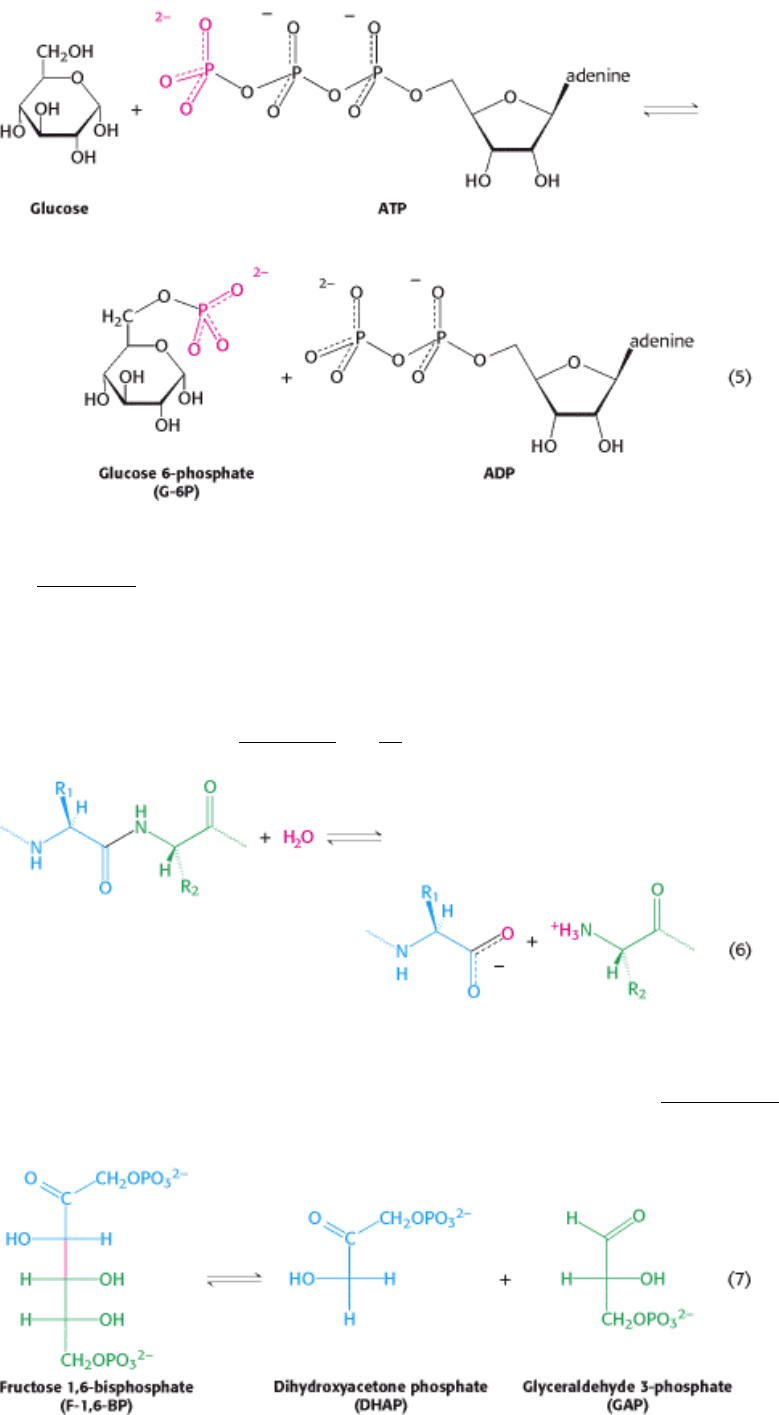
We saw earlier that group-transfer reactions are used to synthesize ATP (14.2.1). We will also see examples of their use
in signaling pathways (Chapter 15).
5. Hydrolytic reactions cleave bonds by the addition of water. Hydrolysis is a common means employed to break down
large molecules, either to facilitate further metabolism or to reutilize some of the components for biosynthetic purposes.
Proteins are digested by hydrolytic cleavage (Chapters 9 and 10). Reaction 6 illustrates the hydrolysis of a peptide to
yield two smaller peptides.
6. The addition of functional groups to double bonds or the removal of groups to form double bonds constitutes the final
class of reactions. The enzymes that catalyze these types of reaction are classified as lyases (Section 8.1.3). An important
example, illustrated in reaction 7, is the conversion of the six-carbon molecule fructose 1,6-bisphosphate (F-1, 6-BP) into
2 three-carbon fragments: dihydroxyacetone phosphate and glyceraldehyde 3-phosphate.
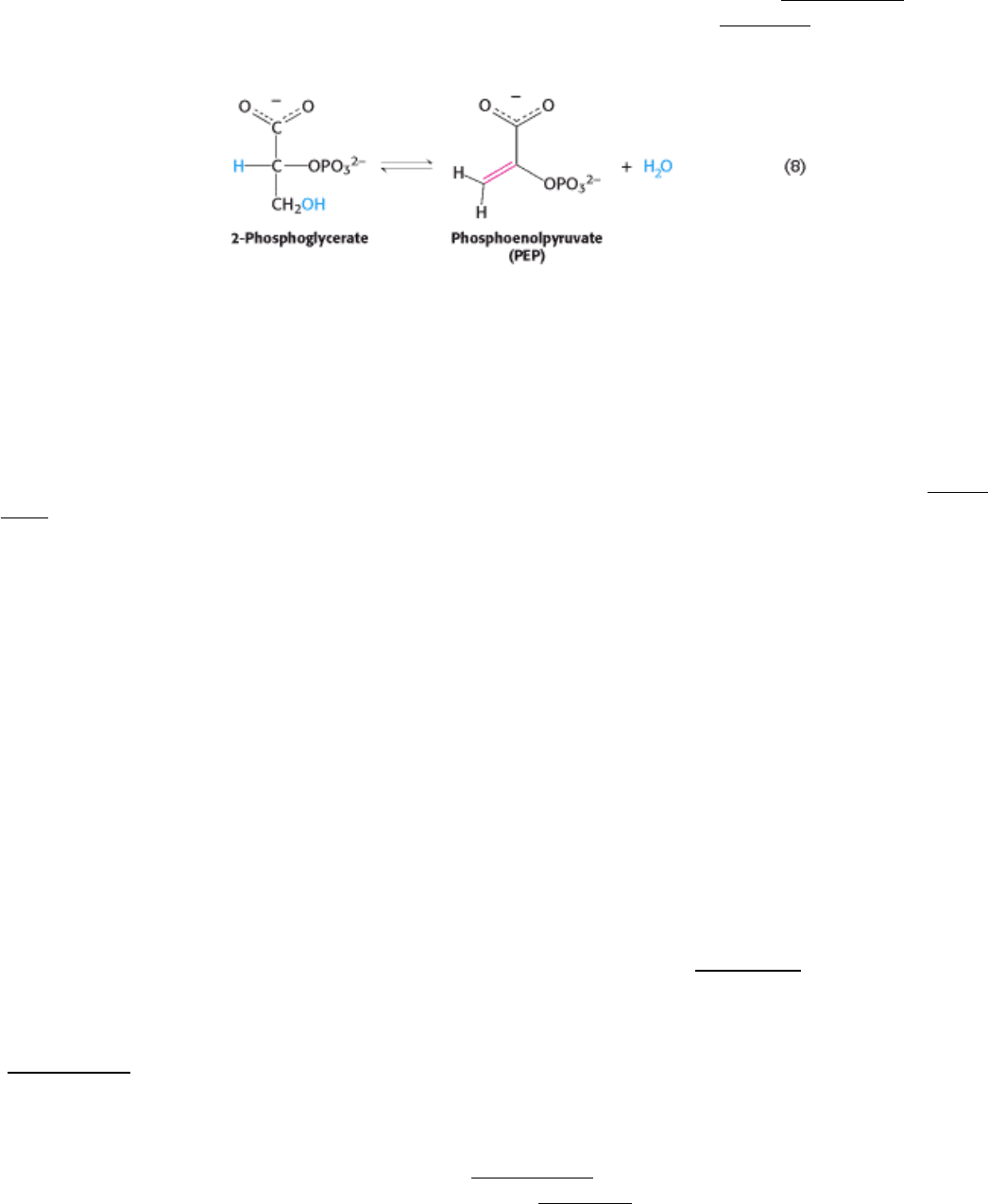
This reaction is a key step in glycolysis, a key pathway for extracting energy from glucose (Section 16.1.3).
Dehydrations to form double bonds, such as the formation of phosphoenolpyruvate (Table 14.1) from 2-
phosphoglycerate (reaction 8), are important reactions of this type.
The dehydration sets up the next step in the pathway, a group-transfer reaction that uses the that uses the high phosphoryl
transfer potential of the product PEP to form ATP from ADP.
These six fundamental reaction types are the basis of metabolism. Remember that all six types can proceed in either
direction, depending on the standard free energy for the specific reaction and the concentration of the reactants and
products inside the cell. As an example of how simple themes are reiterated, consider the reactions shown in Figure
14.17. The same sequence of reactions is employed in the citric acid cycle, fatty acid degradation, the degradation of the
amino acid lysine, and (in reverse) the biosynthesis of fatty acids. An effective way to learn is to look for commonalties
in the diverse metabolic pathways that we will be studying. There is a chemical logic that, when exposed, renders the
complexity of the chemistry of living systems more manageable and reveals its elegance.
14.3.3. Metabolic Processes Are Regulated in Three Principal Ways
It is evident that the complex network of reactions constituting intermediary metabolism must be rigorously regulated. At
the same time, metabolic control must be flexible, because the external environments of cells are not constant.
Metabolism is regulated by controlling (1) the amounts of enzymes, (2) their catalytic activities, and (3) the accessibility
of substrates. The amount of a particular enzyme depends on both its rate of synthesis and its rate of degradation. The
level of most enzymes is adjusted primarily by changing the rate of transcription of the genes encoding them. In E. coli,
the presence of lactose, for example, induces within minutes a more than 50-fold increase in the rate of synthesis of β-
galactosidase, an enzyme required for the breakdown of this disaccharide.
The catalytic activity of enzymes is controlled in several ways. Reversible allosteric control is especially important. For
example, the first reaction in many biosynthetic pathways is allosterically inhibited by the ultimate product of the
pathway. The inhibition of aspartate transcarbamoylase by cytidine triphosphate (Section 10.1) is a well-understood
example of feedback inhibition. This type of control can be almost instantaneous. Another recurring mechanism is
reversible covalent modification. For example, glycogen phosphorylase, the enzyme catalyzing the breakdown of
glycogen, a storage form of sugar, is activated by phosphorylation of a particular serine residue when glucose is scarce
(Section 21.2.1).
Hormones coordinate metabolic relations between different tissues, often by regulating the reversible modification of
key enzymes. Hormones such as epinephrine trigger signal transduction cascades that lead to highly amplified changes in
metabolic patterns in target tissues such as the muscle (Section 15.0.1). The hormone insulin promotes the entry of
glucose into many kinds of cells. As will be discussed again in Chapter 15, many hormones act through intracellular
messengers, such as cyclic AMP and calcium ion, that coordinate the activities of many target proteins.
Controlling the flux of substrates also regulates metabolism. The transfer of substrates from one compartment of a cell to
another (e.g., from the cytosol to mitochondria) can serve as a control point.
An important general principle of metabolism is that biosynthetic and degradative pathways are almost always distinct.
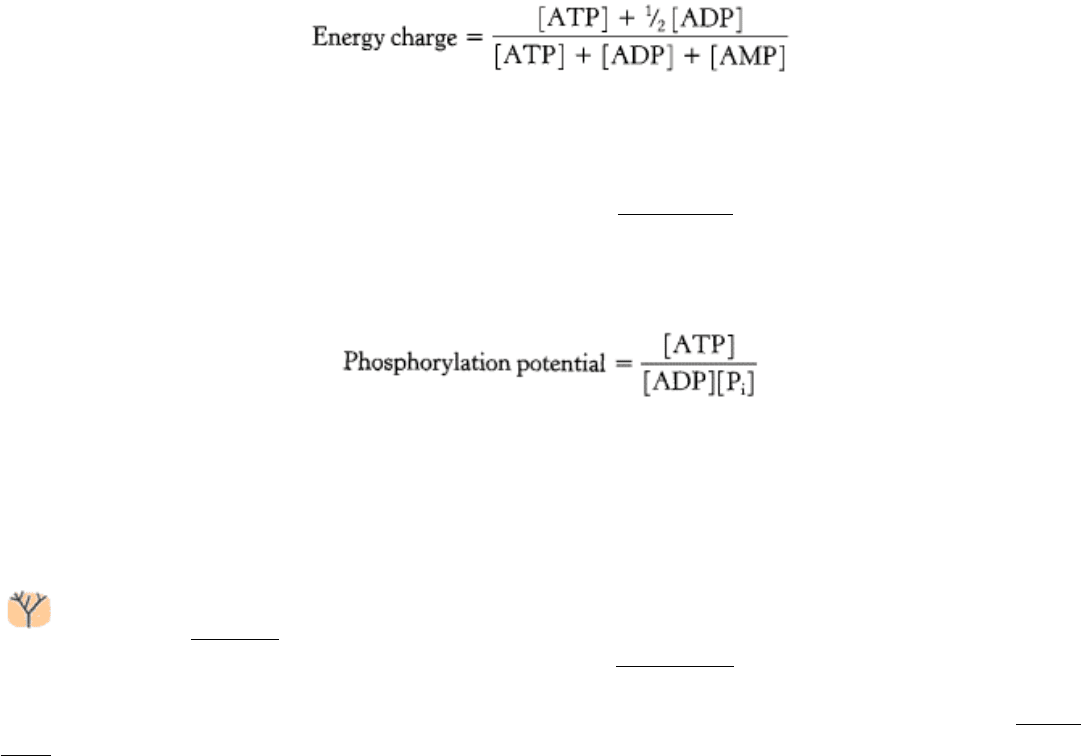
This separation is necessary for energetic reasons, as will be evident in subsequent chapters. It also facilitates the control
of metabolism. In eukaryotes, metabolic regulation and flexibility also are enhanced by compartmentalization. For
example, fatty acid oxidation takes place in mitochondria, whereas fatty acid synthesis takes place in the cytosol.
Compartmentalization segregates opposed reactions.
Many reactions in metabolism are controlled by the energy status of the cell. One index of the energy status is the energy
charge, which is proportional to the mole fraction of ATP plus half the mole fraction of ADP, given that ATP contains
two anhydride bonds, whereas ADP contains one. Hence, the energy charge is defined as
The energy charge can have a value ranging from 0 (all AMP) to 1 (all ATP). Daniel Atkinson showed that ATP-
generating (catabolic) pathways are inhibited by an energy charge, whereas ATP-utilizing (anabolic) pathways are
stimulated by a high-energy charge. In plots of the reaction rates of such pathways versus the energy charge, the curves
are steep near an energy charge of 0.9, where they usually intersect (Figure 14.18). It is evident that the control of these
pathways has evolved to maintain the energy charge within rather narrow limits. In other words, the energy charge, like
the pH of a cell, is buffered. The energy charge of most cells ranges from 0.80 to 0.95. An alternative index of the energy
status is the phosphorylation potential, which is defined as
The phosphorylation potential, in contrast with the energy charge, depends on the concentration of P
i
and is directly
related to the free energy-storage available from ATP.
14.3.4. Evolution of Metabolic Pathways
How did the complex pathways that constitute metabolism evolve? This question, a difficult one to address, was
approached in Chapter 2. The current thinking is that RNA was an early biomolecule and that, in an early RNA
world, RNA served as catalysts and information-storage molecules (Section 2.2.2).
Why do activated carriers such as ATP, NADH, FADH
2
, and coenzyme A contain adenosine diphosphate units (Figure
14.19)? A possible explanation is that these molecules evolved from the early RNA catalysts. Non-RNA units such as
the isoalloxazine ring may have been recruited to serve as efficient carriers of activated electrons and chemical units, a
function not readily performed by RNA itself. We can picture the adenine ring of FADH
2
binding to a uracil unit in a
niche of an RNA enzyme (ribozyme) by base-pairing, whereas the isoalloxazine ring protrudes and functions as an
electron carrier. When the more versatile proteins replaced RNA as the major catalysts, the ribonucleotide coenzymes
stayed essentially unchanged because they were already well suited to their metabolic roles. The nicotin amide unit of
NADH, for example, can readily transfer electrons irrespective of whether the adenine unit interacts with a base in an
RNA enzyme or with amino acid residues in a protein enzyme. With the advent of protein enzymes, these important
cofactors evolved as free molecules without losing the adenosine diphosphate vestige of their RNA-world ancestry. That
molecules and motifs of metabolism are common to all forms of life testifies to their common origin and to the retention
of functioning modules through billions of years of evolution. Our understanding of metabolism, like that of other
biological processes, is enriched by inquiry into how these beautifully integrated patterns of reactions came into being.
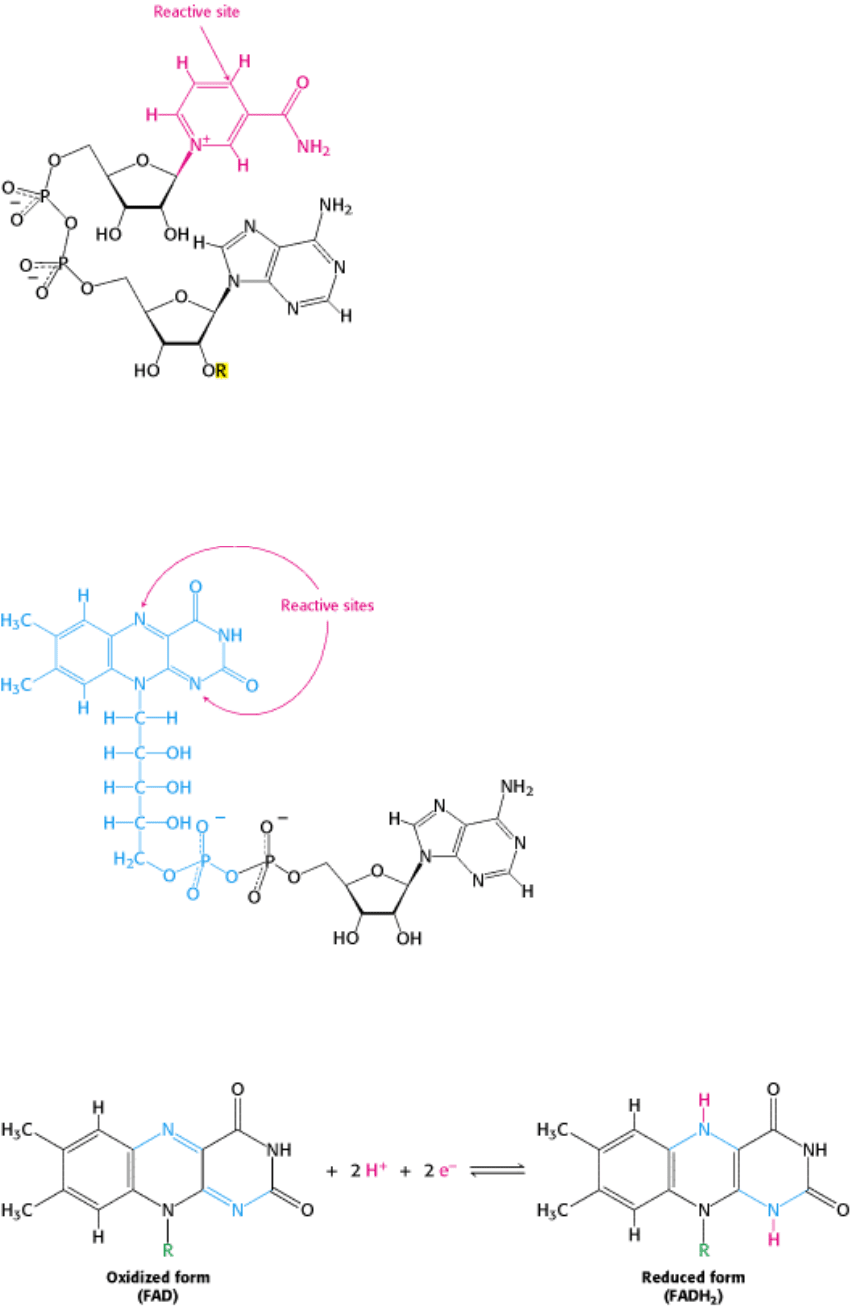
II. Transducing and Storing Energy 14. Metabolism: Basic Concepts and Design 14.3. Metabolic Pathways Contain Many Recurring Motifs
Figure 14.13. Structures of the Oxidized Forms of Nicotinamide-Derived Electron Carriers. Nicotinamide adenine
dinucleotide (NAD
+
) and nicotinamide adenine dinucleotide phosphate (NADP
+
) are prominent carriers of high-energy
electrons. In NAD
+
, R = H; in NADP
+
, R = PO
3
2-
.
II. Transducing and Storing Energy 14. Metabolism: Basic Concepts and Design 14.3. Metabolic Pathways Contain Many Recurring Motifs
Figure 14.14. Structure of the Oxidized Form of Flavin Adenine Dinucleotide (FAD). This electron carrier consists
of a flavin mononucleotide (FMN) unit (shown in blue) and an AMP unit (shown in black).
II. Transducing and Storing Energy 14. Metabolism: Basic Concepts and Design 14.3. Metabolic Pathways Contain Many Recurring Motifs
Figure 14.15. Structures of the Reactive Parts of FAD and FADH
2
. The electrons and protons are carried by the
isoalloxazine ring component of FAD and FADH
2
.
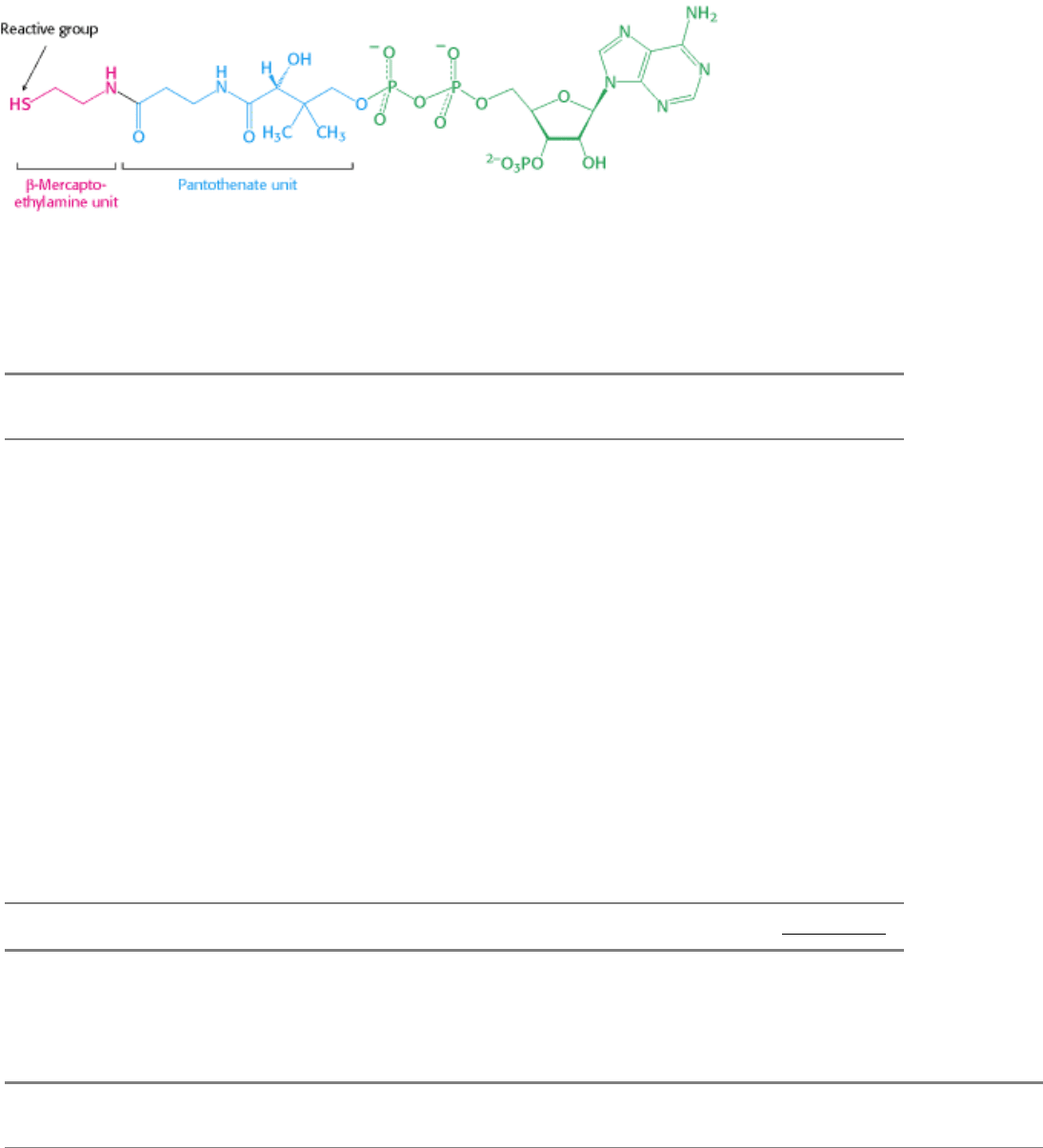
II. Transducing and Storing Energy 14. Metabolism: Basic Concepts and Design 14.3. Metabolic Pathways Contain Many Recurring Motifs
Figure 14.16. Structure of Coenzyme a (CoA).
II. Transducing and Storing Energy 14. Metabolism: Basic Concepts and Design 14.3. Metabolic Pathways Contain Many Recurring Motifs
Table 14.2. Some activated carriers in metabolism
Carrier molecule in activated form Group carried Vitamin precursor
ATP Phosphoryl
NADH and NADPH Electrons Nicotinate (niacin)
FADH
2
Electrons Riboflavin (vitamin B
2
)
FMNH
2
Electrons Riboflavin (vitamin B
2
)
Coenzyme A Acyl Pantothenate
Lipoamide Acyl
Thiamine pyrophosphate Aldehyde Thiamine (vitamin B
1
)
Biotin CO
2
Biotin
Tetrahydrofolate One-carbon units Folate
S-Adenosylmethionine Methyl
Uridine diphosphate glucose Glucose
Cytidine diphosphate diacylglycerol Phosphatidate
Nucleoside triphosphates Nucleotides
Note: Many of the activated carriers are coenzymes that are derived from water-soluble vitamins (Section 8.6.1).
II. Transducing and Storing Energy 14. Metabolism: Basic Concepts and Design 14.3. Metabolic Pathways Contain Many Recurring Motifs
Table 14.3. Types of chemical reactions in metabolism
Type of reaction Description
Oxidation-reduction Electron transfer
Ligation requiring ATP cleavage Formation of covalent bonds (i.e., carbon-carbon bonds)
Isomerization Rearrangement of atoms to form isomers
Group transfer Transfer of a functional group from one molecule to another
Hydrolytic Cleavage of bonds by the addition of water
